Julien Valentin
Look Ma, no markers: holistic performance capture without the hassle
Oct 15, 2024



Abstract:We tackle the problem of highly-accurate, holistic performance capture for the face, body and hands simultaneously. Motion-capture technologies used in film and game production typically focus only on face, body or hand capture independently, involve complex and expensive hardware and a high degree of manual intervention from skilled operators. While machine-learning-based approaches exist to overcome these problems, they usually only support a single camera, often operate on a single part of the body, do not produce precise world-space results, and rarely generalize outside specific contexts. In this work, we introduce the first technique for marker-free, high-quality reconstruction of the complete human body, including eyes and tongue, without requiring any calibration, manual intervention or custom hardware. Our approach produces stable world-space results from arbitrary camera rigs as well as supporting varied capture environments and clothing. We achieve this through a hybrid approach that leverages machine learning models trained exclusively on synthetic data and powerful parametric models of human shape and motion. We evaluate our method on a number of body, face and hand reconstruction benchmarks and demonstrate state-of-the-art results that generalize on diverse datasets.
GeoGen: Geometry-Aware Generative Modeling via Signed Distance Functions
Jun 07, 2024
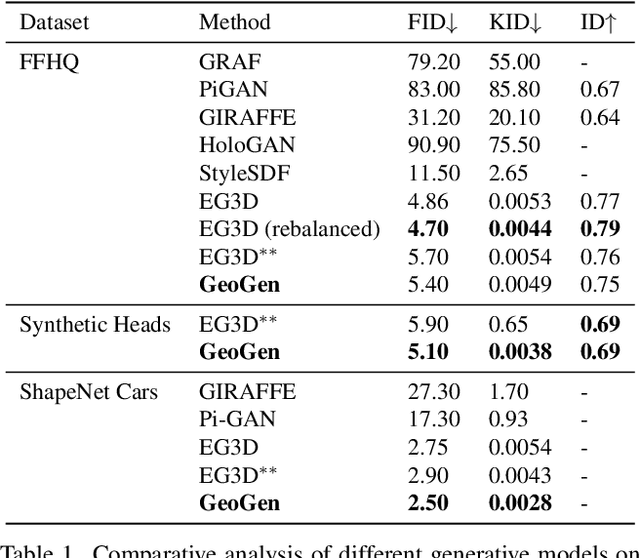
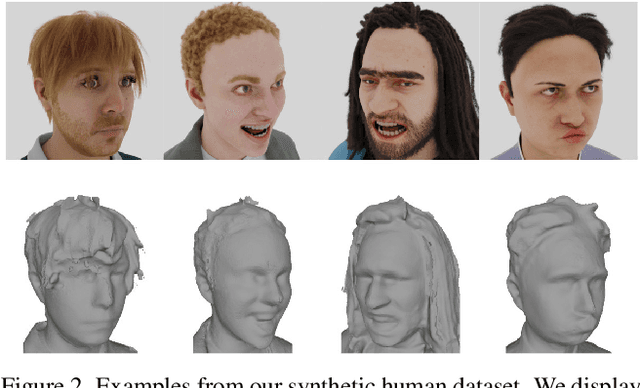
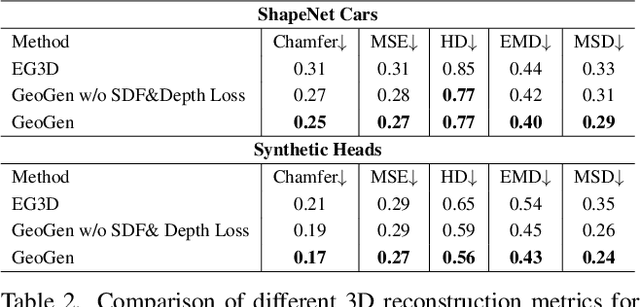
Abstract:We introduce a new generative approach for synthesizing 3D geometry and images from single-view collections. Most existing approaches predict volumetric density to render multi-view consistent images. By employing volumetric rendering using neural radiance fields, they inherit a key limitation: the generated geometry is noisy and unconstrained, limiting the quality and utility of the output meshes. To address this issue, we propose GeoGen, a new SDF-based 3D generative model trained in an end-to-end manner. Initially, we reinterpret the volumetric density as a Signed Distance Function (SDF). This allows us to introduce useful priors to generate valid meshes. However, those priors prevent the generative model from learning details, limiting the applicability of the method to real-world scenarios. To alleviate that problem, we make the transformation learnable and constrain the rendered depth map to be consistent with the zero-level set of the SDF. Through the lens of adversarial training, we encourage the network to produce higher fidelity details on the output meshes. For evaluation, we introduce a synthetic dataset of human avatars captured from 360-degree camera angles, to overcome the challenges presented by real-world datasets, which often lack 3D consistency and do not cover all camera angles. Our experiments on multiple datasets show that GeoGen produces visually and quantitatively better geometry than the previous generative models based on neural radiance fields.
MultiPly: Reconstruction of Multiple People from Monocular Video in the Wild
Jun 03, 2024



Abstract:We present MultiPly, a novel framework to reconstruct multiple people in 3D from monocular in-the-wild videos. Reconstructing multiple individuals moving and interacting naturally from monocular in-the-wild videos poses a challenging task. Addressing it necessitates precise pixel-level disentanglement of individuals without any prior knowledge about the subjects. Moreover, it requires recovering intricate and complete 3D human shapes from short video sequences, intensifying the level of difficulty. To tackle these challenges, we first define a layered neural representation for the entire scene, composited by individual human and background models. We learn the layered neural representation from videos via our layer-wise differentiable volume rendering. This learning process is further enhanced by our hybrid instance segmentation approach which combines the self-supervised 3D segmentation and the promptable 2D segmentation module, yielding reliable instance segmentation supervision even under close human interaction. A confidence-guided optimization formulation is introduced to optimize the human poses and shape/appearance alternately. We incorporate effective objectives to refine human poses via photometric information and impose physically plausible constraints on human dynamics, leading to temporally consistent 3D reconstructions with high fidelity. The evaluation of our method shows the superiority over prior art on publicly available datasets and in-the-wild videos.
360° Volumetric Portrait Avatar
Dec 08, 2023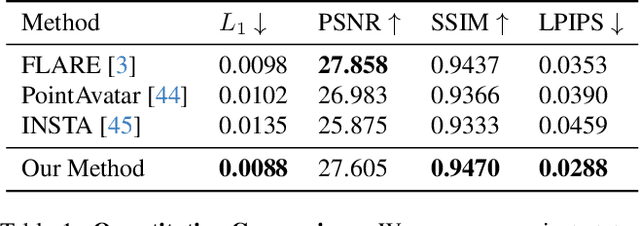


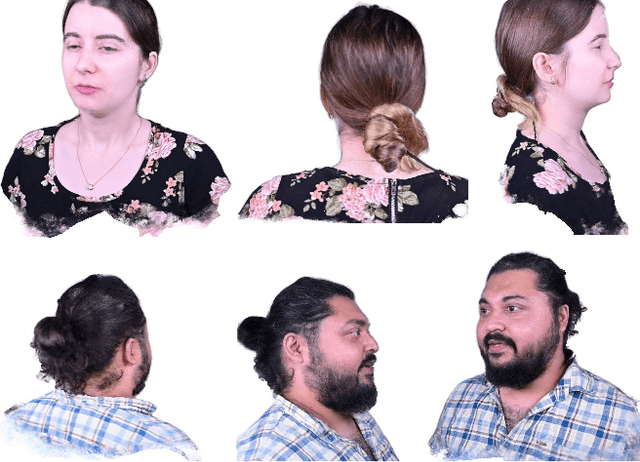
Abstract:We propose 360{\deg} Volumetric Portrait (3VP) Avatar, a novel method for reconstructing 360{\deg} photo-realistic portrait avatars of human subjects solely based on monocular video inputs. State-of-the-art monocular avatar reconstruction methods rely on stable facial performance capturing. However, the common usage of 3DMM-based facial tracking has its limits; side-views can hardly be captured and it fails, especially, for back-views, as required inputs like facial landmarks or human parsing masks are missing. This results in incomplete avatar reconstructions that only cover the frontal hemisphere. In contrast to this, we propose a template-based tracking of the torso, head and facial expressions which allows us to cover the appearance of a human subject from all sides. Thus, given a sequence of a subject that is rotating in front of a single camera, we train a neural volumetric representation based on neural radiance fields. A key challenge to construct this representation is the modeling of appearance changes, especially, in the mouth region (i.e., lips and teeth). We, therefore, propose a deformation-field-based blend basis which allows us to interpolate between different appearance states. We evaluate our approach on captured real-world data and compare against state-of-the-art monocular reconstruction methods. In contrast to those, our method is the first monocular technique that reconstructs an entire 360{\deg} avatar.
BlendFields: Few-Shot Example-Driven Facial Modeling
May 12, 2023
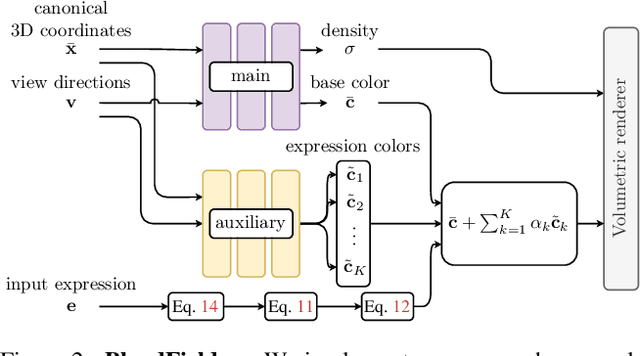
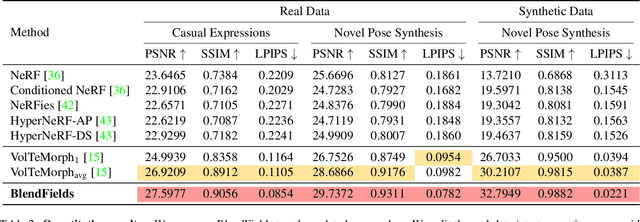
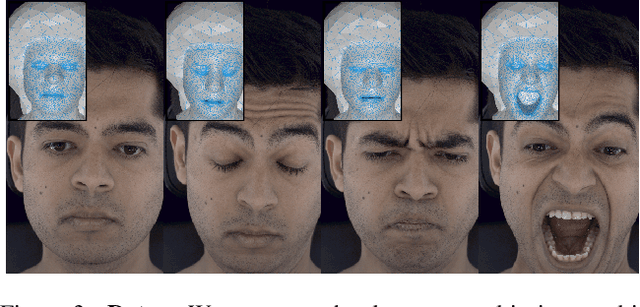
Abstract:Generating faithful visualizations of human faces requires capturing both coarse and fine-level details of the face geometry and appearance. Existing methods are either data-driven, requiring an extensive corpus of data not publicly accessible to the research community, or fail to capture fine details because they rely on geometric face models that cannot represent fine-grained details in texture with a mesh discretization and linear deformation designed to model only a coarse face geometry. We introduce a method that bridges this gap by drawing inspiration from traditional computer graphics techniques. Unseen expressions are modeled by blending appearance from a sparse set of extreme poses. This blending is performed by measuring local volumetric changes in those expressions and locally reproducing their appearance whenever a similar expression is performed at test time. We show that our method generalizes to unseen expressions, adding fine-grained effects on top of smooth volumetric deformations of a face, and demonstrate how it generalizes beyond faces.
Dynamic Point Fields
Apr 06, 2023Abstract:Recent years have witnessed significant progress in the field of neural surface reconstruction. While the extensive focus was put on volumetric and implicit approaches, a number of works have shown that explicit graphics primitives such as point clouds can significantly reduce computational complexity, without sacrificing the reconstructed surface quality. However, less emphasis has been put on modeling dynamic surfaces with point primitives. In this work, we present a dynamic point field model that combines the representational benefits of explicit point-based graphics with implicit deformation networks to allow efficient modeling of non-rigid 3D surfaces. Using explicit surface primitives also allows us to easily incorporate well-established constraints such as-isometric-as-possible regularisation. While learning this deformation model is prone to local optima when trained in a fully unsupervised manner, we propose to additionally leverage semantic information such as keypoint dynamics to guide the deformation learning. We demonstrate our model with an example application of creating an expressive animatable human avatar from a collection of 3D scans. Here, previous methods mostly rely on variants of the linear blend skinning paradigm, which fundamentally limits the expressivity of such models when dealing with complex cloth appearances such as long skirts. We show the advantages of our dynamic point field framework in terms of its representational power, learning efficiency, and robustness to out-of-distribution novel poses.
X-Avatar: Expressive Human Avatars
Mar 09, 2023Abstract:We present X-Avatar, a novel avatar model that captures the full expressiveness of digital humans to bring about life-like experiences in telepresence, AR/VR and beyond. Our method models bodies, hands, facial expressions and appearance in a holistic fashion and can be learned from either full 3D scans or RGB-D data. To achieve this, we propose a part-aware learned forward skinning module that can be driven by the parameter space of SMPL-X, allowing for expressive animation of X-Avatars. To efficiently learn the neural shape and deformation fields, we propose novel part-aware sampling and initialization strategies. This leads to higher fidelity results, especially for smaller body parts while maintaining efficient training despite increased number of articulated bones. To capture the appearance of the avatar with high-frequency details, we extend the geometry and deformation fields with a texture network that is conditioned on pose, facial expression, geometry and the normals of the deformed surface. We show experimentally that our method outperforms strong baselines in both data domains both quantitatively and qualitatively on the animation task. To facilitate future research on expressive avatars we contribute a new dataset, called X-Humans, containing 233 sequences of high-quality textured scans from 20 participants, totalling 35,500 data frames.
DigiFace-1M: 1 Million Digital Face Images for Face Recognition
Oct 05, 2022

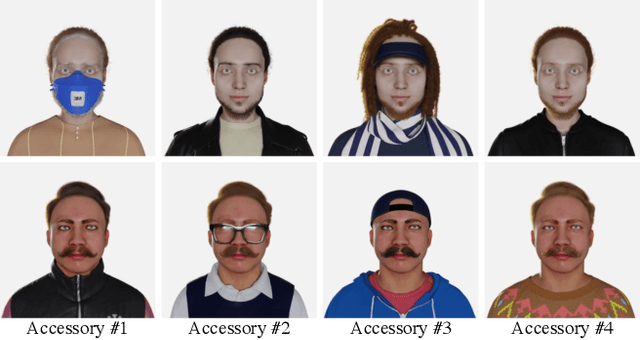

Abstract:State-of-the-art face recognition models show impressive accuracy, achieving over 99.8% on Labeled Faces in the Wild (LFW) dataset. Such models are trained on large-scale datasets that contain millions of real human face images collected from the internet. Web-crawled face images are severely biased (in terms of race, lighting, make-up, etc) and often contain label noise. More importantly, the face images are collected without explicit consent, raising ethical concerns. To avoid such problems, we introduce a large-scale synthetic dataset for face recognition, obtained by rendering digital faces using a computer graphics pipeline. We first demonstrate that aggressive data augmentation can significantly reduce the synthetic-to-real domain gap. Having full control over the rendering pipeline, we also study how each attribute (e.g., variation in facial pose, accessories and textures) affects the accuracy. Compared to SynFace, a recent method trained on GAN-generated synthetic faces, we reduce the error rate on LFW by 52.5% (accuracy from 91.93% to 96.17%). By fine-tuning the network on a smaller number of real face images that could reasonably be obtained with consent, we achieve accuracy that is comparable to the methods trained on millions of real face images.
VolTeMorph: Realtime, Controllable and Generalisable Animation of Volumetric Representations
Aug 01, 2022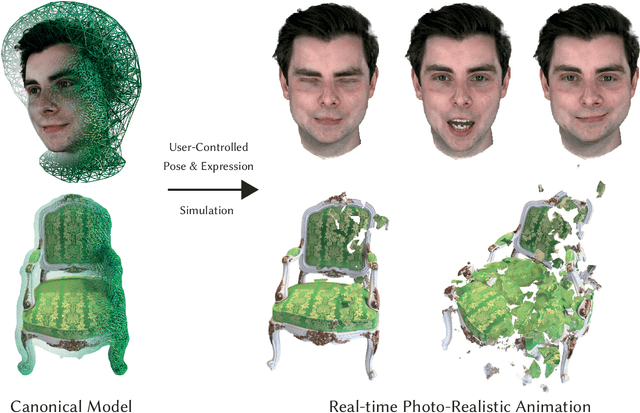
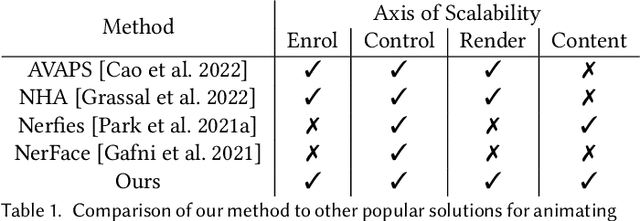
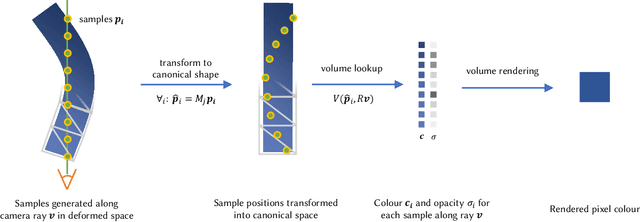
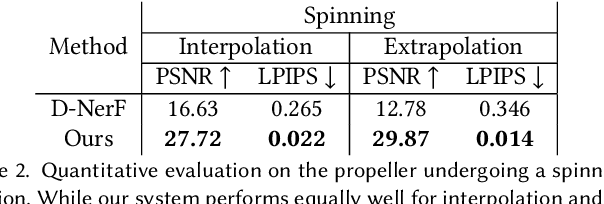
Abstract:The recent increase in popularity of volumetric representations for scene reconstruction and novel view synthesis has put renewed focus on animating volumetric content at high visual quality and in real-time. While implicit deformation methods based on learned functions can produce impressive results, they are `black boxes' to artists and content creators, they require large amounts of training data to generalise meaningfully, and they do not produce realistic extrapolations outside the training data. In this work we solve these issues by introducing a volume deformation method which is real-time, easy to edit with off-the-shelf software and can extrapolate convincingly. To demonstrate the versatility of our method, we apply it in two scenarios: physics-based object deformation and telepresence where avatars are controlled using blendshapes. We also perform thorough experiments showing that our method compares favourably to both volumetric approaches combined with implicit deformation and methods based on mesh deformation.
3D face reconstruction with dense landmarks
Apr 06, 2022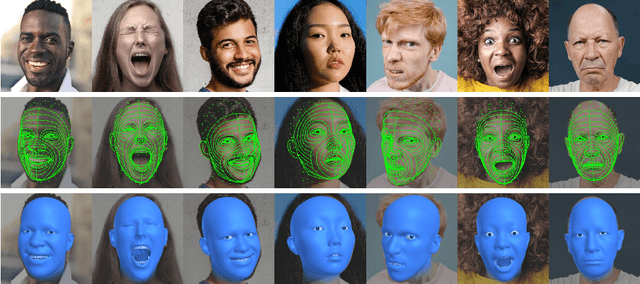



Abstract:Landmarks often play a key role in face analysis, but many aspects of identity or expression cannot be represented by sparse landmarks alone. Thus, in order to reconstruct faces more accurately, landmarks are often combined with additional signals like depth images or techniques like differentiable rendering. Can we keep things simple by just using more landmarks? In answer, we present the first method that accurately predicts 10x as many landmarks as usual, covering the whole head, including the eyes and teeth. This is accomplished using synthetic training data, which guarantees perfect landmark annotations. By fitting a morphable model to these dense landmarks, we achieve state-of-the-art results for monocular 3D face reconstruction in the wild. We show that dense landmarks are an ideal signal for integrating face shape information across frames by demonstrating accurate and expressive facial performance capture in both monocular and multi-view scenarios. This approach is also highly efficient: we can predict dense landmarks and fit our 3D face model at over 150FPS on a single CPU thread.
 Add to Chrome
Add to Chrome Add to Firefox
Add to Firefox Add to Edge
Add to Edge